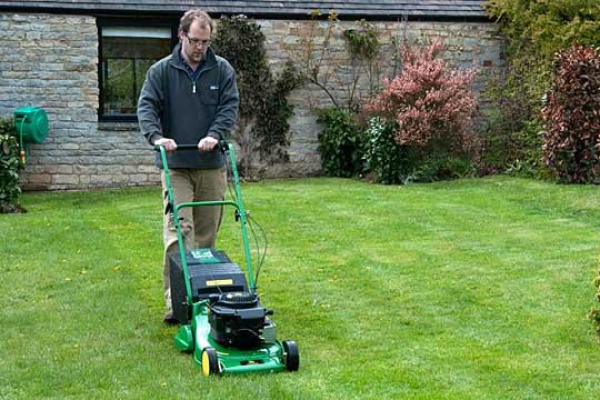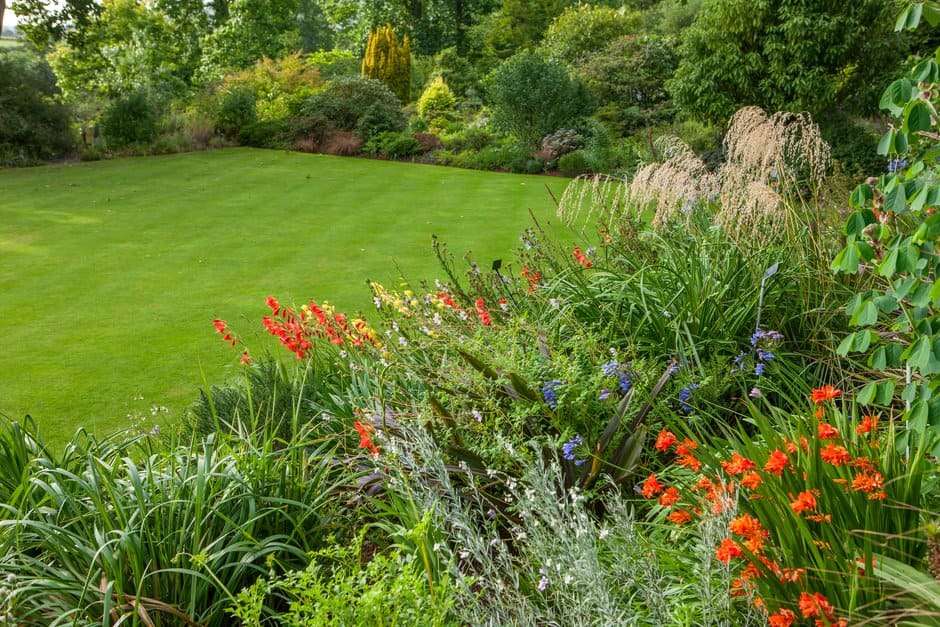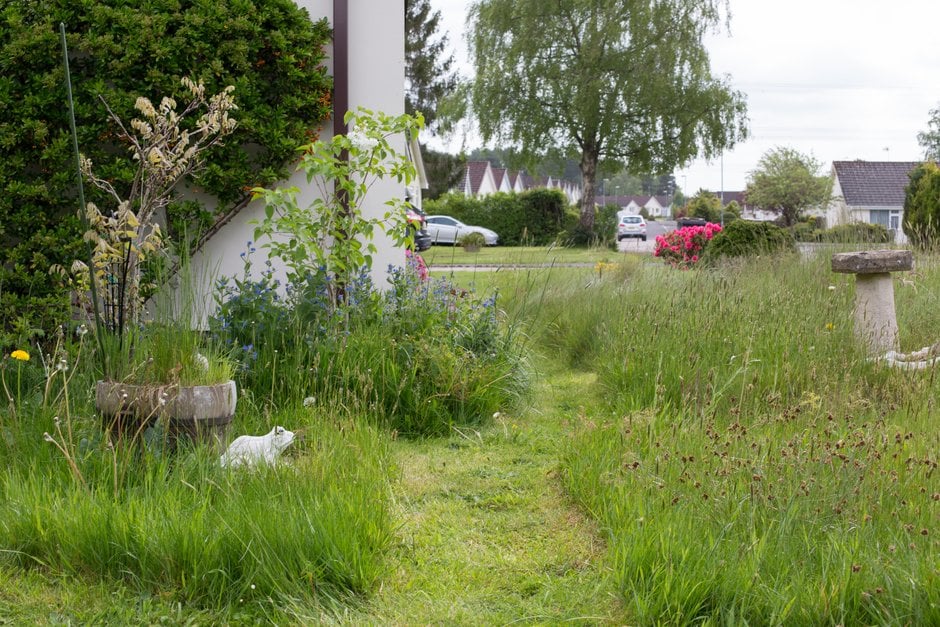Lawn mowing guide
Find out how and when to mow, which type of mower to choose, and how to adapt your mowing routine to suit your style of lawn, from close-cut turf to longer flower-rich grass.

Quick facts
- Blunt mower blades rip and tear grass, this affects the health of a lawn and looks unsightly
- Fine lawns are kept shorter and mown more frequently than ordinary domestic lawns
- A push mower does not need fuel or electricty, making it a good, environmentally sound option for small lawns
Jump to
How and when to mow
Lawns should generally be mown weekly or fortnightly between March and October to keep them neat and in good condition. As well as improving the look of a lawn, regular mowing helps to eliminate unwanted weeds and encourages denser turf.
Mowing itself is relatively straight forward and gets easier with time and practice, although it can take a few sessions to get used to a new lawn or new mower. See our step-by-step mowing guide:

How to mow a lawn
How often you mow depends on the style of lawn you want, weather conditions and the speed at which your grass is growing:
-
In spring and autumn: with a conventional lawn, mow once a fortnight or once a week, depending on growth. For a flower-rich lawn or wildflower meadow, leave uncut in spring to provide much needed support to pollinators and a welcome break from mowing – see No Mow May, below
-
In summer: with a conventional lawn, mow once a week on average, dropping to once a fortnight, or longer, during periods of drought. Flower-rich lawns can be mown every four to six weeks. Long-grassed lawns are best cut once or twice over the summer, usually not before June
-
In winter: mowing is usually not necessary, unless the weather is mild and the grass is still growing. In this case, mow occasionally on a high cut setting. Never mow if the ground conditions are very soft, wet or frozen, or during spells of cold, drying winds
-
In dry, shady areas under trees: grass may need less frequent mowing than areas in full sun with good moisture levels
If you want to encourage wildflowers in your lawn, try No Mow May. As the name suggests, you simply stop mowing in early May, which allows the wild plants already in your lawn to grow up and flower, adding colour and attracting pollinating insects and other wildlife. You can leave your whole lawn uncut or just a section. Then either re-start mowing in June or leave the grass uncut until August to encourage a greater diversity of plants. See our guide to starting a wildflower meadow, which includes advice on converting your lawn, and our wildlife gardening section for more biodiversity tips.
Get more information on No Mow May from the campaign organiser, wildflower charity Plantlife.

Creating wildflower meadows

Lawn and mini-meadow habitats
Cutting heights
Nearly all mowers let you adjust the cutting height to suit different times of year and styles of lawn. This is usually a simple process of switching a dial or moving a lever. It’s important to change the cutting height to help keep your grass in good condition. A higher cut also allows smaller wildflowers to thrive, for a flower-rich lawn.
Aim to mow regularly, so you only need to remove a small amount each time – never take off more than one-third of the grass height. As a general rule, aim to keep the grass at the following heights:
-
13–25mm (½–1in) in summer and up to 40mm (1½in) in spring and autumn for ordinary domestic lawns
-
6–13mm (¼–½in) for fine lawns
With new lawns, wait until the grass is at least 5cm (2in) tall before mowing with the blades on the highest setting.
Mowing tips
-
For the first mow in spring or when cutting long grass, choose the highest blade setting, to avoid choking the mower with clippings. If the grass is really long, you may need to strim it first to reduce the overall height, then rake up the cut grass, before going over with the mower to tidy up as best you can. It can often look a bit scruffy and yellow, but will soon green up and look neater with more regular cuts
-
When mowing long grass with a hover mower, cut narrower strips so the blade doesn’t get clogged up with cut grass
-
Avoid excessively close mowing – although attractive, this can weaken the grass plants, encouraging shallow rooting and making the lawn more susceptible to drought damage, weeds and moss. Close-mown lawns also need more frequent maintenance and feeding. Extremely low cutting may also scalp the lawn, leaving bare patches where there are bumps or tree roots at the surface
-
Lawns regularly left too long can suffer from loose, weak growth that is less durable as a surface for back garden sports and regular foot traffic
Getting a striped lawn
A striped lawn always looks impressive and isn’t that difficult to achieve if your mower has a rear roller. Wheeled rotary mowers (without a rear roller) won’t produce good quality striping. Rectangular lawns are easier to stripe than irregularly shaped lawns, but with a bit of practice, you can stripe up any lawn:
-
Start by mowing around the edge of the lawn
-
For square or rectangular lawns, work from the left side, mowing up and down the lawn using the straight lawn edge as a guide to get a straight line
-
For circular or irregular-shaped lawns, line up the mower with a focal point to achieve an initial straight line across the widest point. This first straight line can be your guide for subsequent stripes
-
At each turn, line up the mower so that the next mown stripe slightly overlaps the last
-
Empty the clippings box regularly – a full box can deposit clumps of clippings on the lawn, spoiling the finish and clogging the mower
-
The lawn’s corners may need cutting separately, using lawn shears or a strimmer, if they’re too tight or boxed in for the mower to reach
It’s a good idea to vary the direction of cut regularly, alternating straight with diagonal stripes, so that ruts don’t form in the lawn from going backwards and forwards in the same direction too often.
Mower care and safety
Clean, sharp mower blades will give the best cut. You can sharpen rotary blades yourself, but be absolutely certain the mower is switch off and/or unplugged before going anywhere near the blades. It’s best to take cylinder mowers to a professional.
Give your mower a quick clean after regular use and a full clean and check before putting it away for winter. This will help to minimise the need for repairs and keep your mower running well for years to come.
When using an electric mower, be sure to fit a residual current device (RCD) to the plug, so the mower will stop if the cord is accidentally cut.
With petrol mowers, always store spare petrol safely and take great care when refuelling.
Check regularly that the dead man's handle is functioning correctly, so that the mower cuts out instantly if you let go.
Always wear robust footwear when mowing, however warm the weather.
When cutting rough grass or if there might be gravel, stones or other debris in the lawn, wear good eye protection.
When strimming, wear full protective gear, including steel toe cap boots, heavy-duty gloves and safety goggles, and check areas of long grass for wildlife, such as hedgehogs, before you start.
See our guide to using electricity safely outdoors:
Electricity in the garden
Buying a new mower
If you're considering buying a new mower, you have a wide range of options. They can be powered in various ways and have different methods of cutting, each with pros and cons. As this will probably be one of your most-used pieces of powered gardening equipment and can be quite a big investment, take care to select the type that will best suit your needs.
Power sources
-
Hand-push mowers are suitable for small areas of grass. They’re quiet, with zero running costs, provide good exercise and are environmentally friendly. They’re one of the cheapest options too, but can be tiring to use on anything but a small lawn
-
Electric mowers are usually at the cheaper end of the market, lightweight and ideal for mowing a small lawn with a nearby plug or extension reel. They aren’t as powerful as petrol mowers and the power cord can be limiting in larger gardens
-
Cordless battery-powered mowers are becoming the norm, with improving battery run/charge times and power. Investing in a system of garden power tools using interchangeable battery packs will save on storage space and reduce costs. They provide quieter mowing with green credentials. After mowing, remove the battery and store in a dry, frost-free location. Batteries need to cool down before they will begin to charge, so having two or more is best for a full day in the garden using various battery-powered tools. Robot mowers (see below) are also in this category, automatically returning to their docking station to recharge regularly
-
Petrol mowers are free from an electrical supply, but you do need to remember to fill up the petrol can, and the running costs can be quite high, depending on fuel prices. Noise pollution and fumes are also something to consider
Mower types
There are four main styles of mower that cut in different ways: cylinder, rotary, hover and ride-on. There are also several variations on these, including robotic mowers and mulching mowers. And for longer grass, there are strimmers and scythes.
Different mowers provide different qualities of finish, have varying eco-credentials and are suitable for different sizes and types of lawn. The main choices are as follows:
-
Cylinder mowers give the highest quality cut, suitable for fine lawns and sports turf. The blades are arranged on a cylinder and cut with a scissor-like action. This produces a very fine cut and a striped finish, and allows very low cutting heights
-
Rotary mowers are suitable for most domestic lawns. They have a horizontally spinning blade. The cut isn’t as fine as cylinder mowers, but they cut longer grass and handle uneven surfaces much better than cylinders. Models with a rear roller will also give a striped finish
-
Hover mowers are a type of rotary mower, but they sit on a cushion of air instead of wheels. Self-propelled versions aren’t available, but they’re relatively light to handle, gliding over the grass. They can cope with fairly rough grass and a few bumps, and give a smoother finish when used regularly
-
Mulching mowers are another type of rotary mower. While most lawn mowers come with a collection box to gather the clippings, these instead chop the clippings very finely and deposit them back into the turf, where they settle as a fine layer at the base of the grass and are barely visible. This returns some of the nutrients lost in the clippings back to the root zone, and can help hold moisture in the soil. They're also a good choice if you’re unable to compost all your clippings. However, when used on longer grass they can produce excess clippings that may need to be collected afterwards. Choose a model that can mulch or collect, so you have a choice
-
Robot mowers were once a sci-fi dream, but are now widely available to keep your lawn effortlessly in trim. However, they can be costly and initial set-up can cause a few headaches, but once in place they methodically work their way around their allotted patch, to maintain the grass at a set height
-
Ride-on mowers are really just for very large lawns. They can have cylinder or rotary blades, and can be petrol or battery powered. Although on the expensive side, they’ll reduce your mowing time. A self-propelled mulching mower is a cheaper alternative for large lawns, with the added bonus of keeping you fit
-
Strimmers, hand scythes or power scythes are better than conventional mowers for cutting grass that is allowed to grow very long between cuts. See our advice on wildflower meadows
Other considerations
Lawn type: pick a mower that suits your style of lawn. If you’re after a high-quality finish, such as a bowling green or very fine turf, consider a cylinder mower. This cuts a lot shorter and creates stripes. For a typical well-used and well-loved patch of grass, a rotary or a hover mower is usually ideal
Lawn size: mowing a large lawn can take more than an hour, but a model with a wider cut could save significant time for only a modest increase in price. If your lawn is really large, consider a self-propelled or ride-on mower, or converting some of it to meadow
Problem solving
Avoid scalping the lawn when you mow, leaving bare patches. This can easily happen:
- on soft ground (when the wheels sink in)
- on turns (if they’re taken too fast)
- if ruts form in the lawn from not varying the direction of cut
- if the height of cut is too low
- if the lawn surface is uneven, with bumps and hollows. These are best levelled out. See our advice on repairing lawns for further information
If you get an uneven finish with torn grass, it could be due to any of the following:
- blunt mower blades
- when the bottom and cylinder blades of a cylinder mower are incorrectly set – check your manual for how to adjust them
- when the grass has been left to get very long
- if the mower is operated too fast
- when the cutting height is set to maximum
- hovering over the grass rather than cutting it
See also...
How to mow a lawn
Lawns: spring and summer care
Lawns: autumn care
Lawns: repairing
Moss on lawns
Lawn weeds
All about lawns
Get involved
The Royal Horticultural Society is the UK’s leading gardening charity. We aim to enrich everyone’s life through plants, and make the UK a greener and more beautiful place.